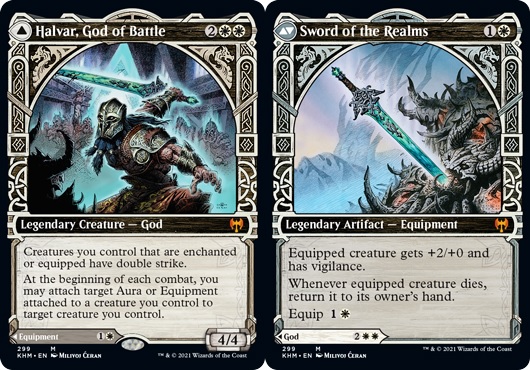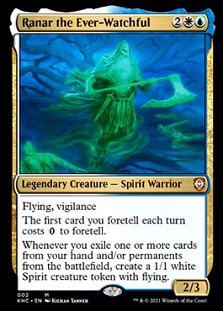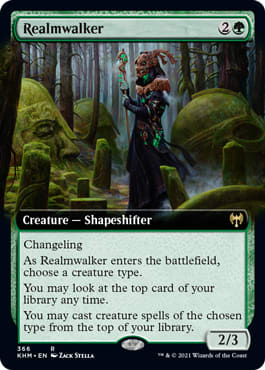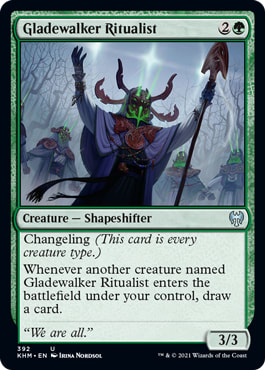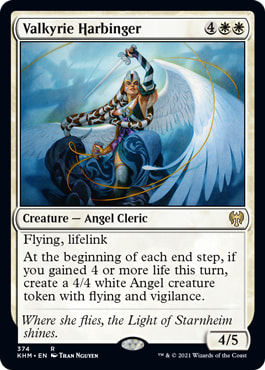Kaldheim is coming and I couldn't be more excited. I'm sure many readers familiar with me might think I'm excited for the set because of how much of a metalhead I am, but in truth I'm most excited because of the Norse lore behind the set. I've been enamored by Norse mythology since I was in college and it's filling me with absolute glee seeing the many ways it's influencing the set thus far. So, I figured, why not talk a bit about the mythology behind some of what we've seen thus far for those who might not be as familiar.
As a small disclaimer: I'm not an expert in Norse mythology and culture and as such, I may flub some aspects or gloss over others. I still hope that in spite of that, I can inform others with a more base knowledge and perhaps encourage them to look a little further themselves.
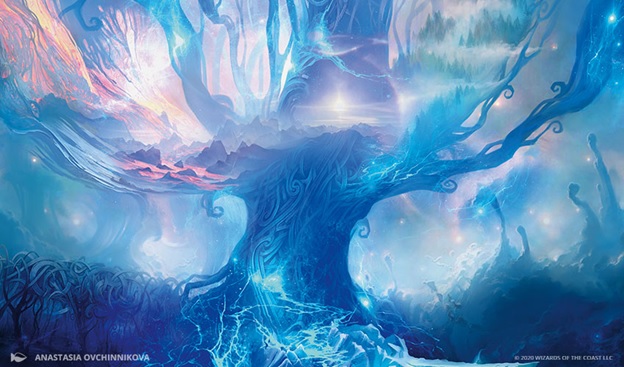
Let's start with a big one. Many cultures have their own unique look at the creation of the world and also ways it exists. In Norse mythology, there is Yggdrasil - the World Tree. Yggdrasil is the tree at the center of the cosmos that holds the various realms such as Midgard, Asgard, Alfheim, Vanaheim, Jötunheim, and more around it. We know that on Kaldheim, these include places like Axgard, which is the home of the dwarves, Surtland, the home of the giants, or jötnar as they're known in Norse mythology, and Starnheim which is the set's Valhalla analogue. A neat note with regards to Surtland is that Surt is the name of the giant that faces off against the gods and burns the world during Ragnarok. I expect that we'll find out more of these realms as preview season continues.
The tree in Norse myth also is home to several animals. Among these there is an eagle who sits atop the tree and a dragon known as Nidhogg who bites at the roots of the tree. Between them, travelling up and down the tree to deliver messages - and frequently insults - to these two beings is the squirrel Ratotoskr. He should be getting a Magic analogue in the form of a legendary squirrel thanks to Mark Rosewater's set teaser. You might also find four stags who nip at the tree's branches for food.
We don't yet know the name of this tree in Kaldheim (the set's trailer simply refers to it as "the World Tree"), but it's clear that it will be a key element to the set's story. In the trailer, we see an unnamed figure with their back to us as viewers laughing as they move in to steal the sword that sits in front of the tree.
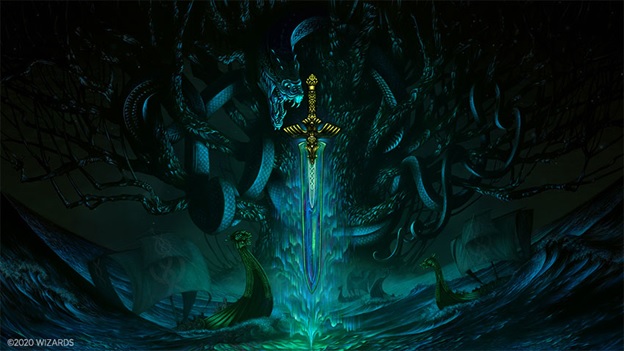
In the tree's branches, as well as the set's key art (shown above), we see a monstrous serpent. This is clearly a reference to Jormungandr, or the World Serpent, who is one of three children of Loki and a giant named Angrboda. In Norse mythology, it is thrown into the ocean surrounding Midgard and grows to be so large that he encircles the entire world and grabs its own tail. During Ragnarok, it lets go of its tail, causing great turmoil in the seas. It is eventually bested by Thor, but Thor himself dies of the serpent's venom - becoming one of the numerous deaths among the gods.
I should also mention here that so many gods die during Ragnarok that it's almost unique among mythologies. Many were taken aback by the fact that the gods of Kaldheim can actually die, but when you consider this side of the mythology where everything ends with absolute finality, it makes sense and is extremely flavorful. Halvar himself is likely based off of someone like Tyr, the one-handed god of war, but in truth there are so many gods of war among Norse gods, it's hard to say who his direct counterpart is.
The being who makes Tyr one-handed is actually the great wolf Fenrir. Many readers may recognize Fenrir from his appearance in Thor: Ragnarok where he is basically a minion of Hela, the film's villain. In the original myths, however, Fenrir was a monstrous wolf who was a sibling to Jormungandr and Hel, the goddess of the dead. This also means Hel is, as you might guess, a child of Loki instead of Odin as many may believe from the aforementioned film.
Fenrir takes Tyr's hand when the gods act to bind him, as he begins to grow too out of control for them to handle. When the gods brought the bindings of Gleipnir to hold the wolf, Tyr placed his arm in Fenrir's jaws as a show of good faith when Fenrir showed distrust. When the gods refused to release Fenrir, he bit off Tyr's hand, leaving him one-handed to show his betrayal. Fenrir's bindings would come undone during Ragnarok and he devours Odin, the ruler of the gods, before he himself is felled by Odin's son Vidar. Prior to this battle, Fenrir's children also devour the sun and the moon as a sign of the beginning of Ragnarok.
Many of the things that happen during Ragnarok are actually told through prophecies, and there are several other instances of prophecy and divination throughout Norse mythology. It makes sense, then, to see the foretell mechanic mentioned on Ranar, the Ever-Watchful, even when we know little to nothing about the mechanic itself. I've seen speculations that could indicate it's similar to forecast from Dissension or suspend from Time Spiral. Either way, there's no doubt that it should make for some spectacularly flavorful goodness.
In terms of similar recurring things in Norse mythology, shapeshifting is a common occurrence. Loki is most notable on this front, shapeshifting in several stories. In one such instance, he turns into a fly in an attempt to cause a dwarven craftsman to flounder in creating items for the gods - including Thor's hammer Mjölnir - in a bet that the dwarf could make items of the same quality as his brother. In another, he appears to take the form of the giant Thökk, saying she will not weep for Baldur, the god who was killed by Loki's machinations and whom Hel agreed to revive if all living beings would weep for him.
He was also involved in an instance where he turned into a mare to lure away a stonemason's horse. The stonemason had bet the gods that he could build a wall around Asgard within a certain timeframe with no additional human help for the hand of the beautiful Freyja, as well as the sun and the moon. The gods agree to this, as they believe he would be unable to complete this task within this timeframe. Despite this, he nearly succeeds, and the gods pressure Loki to find a solution since he suggested they allow the stonemason to have his horse. When Loki draws the horse away, the stonemason goes into a fit of rage and reveals his true form as a giant, whom Thor promptly kills. There's a little more that happens beyond that but, well, you can look up that bit yourself.
These aren't the only times people in Norse mythology where shapeshifting happens either. Odin is known to frequently shapeshift in his travels throughout the nine realms, for example. Given that it is a fairly common theme that shows up, it's hardly a surprise to see shapeshifters in Kaldheim, though it is extremely welcome to see them in the form of changelings. It's fitting given the number of forms shapeshifters tend to take among the many stories of Norse mythology.
You might think it interesting that sagas are here when unlike the previous sets that had them (Dominaria and Theros: Beyond Death) there isn't previous lore to go off of. In truth, it's the perfect set for sagas to show up in - namely because we get the term itself from Norse mythology and legend.
In fact, here's the definition per dictionary.com:
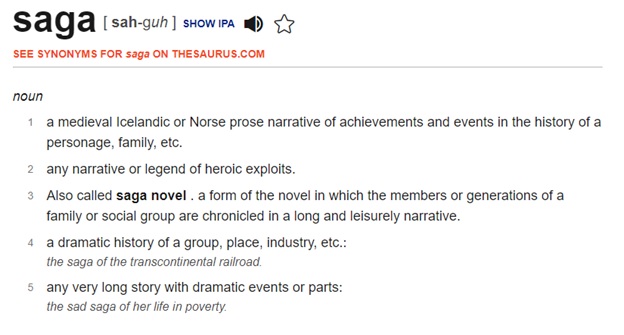
We may not currently know the background for several of these sagas, but I've no doubt that they belong in a set such as Kaldheim. I'm sure we'll get the actual lore behind them all with time, and I for one can't wait.
Magda is a pretty clear reference to a specific character in Norse mythology: Fafnir. Fafnir was the son of the dwarf king Hreidmar, who was paid a ransom of cursed gold and a ring in exchange for the gods who were held captive for slaying an otter. As it happens, the otter was actually another of the dwarf king's sons who took the form of an otter during the day. When the gods left, Fafnir became enamored by the treasure and killed his father to take the gold for himself. As a result of his greed, he became a dragon to protect his treasure, until he eventually died by the hand of Sigurd, the son of Fafnir's brother Regin in revenge for his deeds against their family.
A similar modern-day version of this could also be the dragon Smaug and the dwarves of the Misty Mountain from J. R. R. Tolkien's The Hobbit. Here, Smaug hordes a treasure trove of gold and riches within the mountain that the dwarves once called home. Smaug was attracted here by the greed and hoarding of the dwarven king, whose grandson Thorin Oakenshield would later come to reclaim. Sound familiar? It's no secret that Tolkien borrowed heavily from Norse mythology and it's plain as day in this instance.
So, is Magda Fafnir? Not quite, but the parallels are there and the card is without a doubt a reference to this classic myth.
The valkyries are an interesting bunch. Often seen as angels - or as close to it as you might get in Norse mythology - they bring those who die in battle to their afterlife. While many who die go to Helheim where Hel resides, those who are slain in combat are either brought to Valhalla - as many reading this are likely familiar - or to Freyja's field of Folkvangr. They are also depicted as being ferocious in battle itself. As such, it might seem unusual to see angels in Black in many Magic sets, but not Kaldheim. Here, in fact, it makes perfect sense, and I can't wait to see what other designs they inspire. If there isn't a valkyrie that reanimates a creature somewhere in the set, we riot.
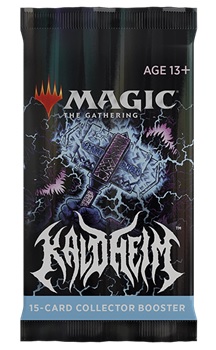
Last but not least, let's talk about the sweet art shown on the Kaldheim Collector Boosters! Not only is the art and packaging here super metal, but it also depicts Magic's version of Mjölnir, the hammer of Thor. You know it, you love it, you've seen Captain America wield it in Endgame, but let's talk a bit about the weapon itself!
Remember the myth I mentioned where Loki turns into a fly to sabotage the dwarven craftsmen and win a bet? Well, this came about because he cuts off Sif's hair. Thor, who is Sif's husband, threatens Loki to within an inch of his life to which Loki swears that he will have the Svartalfar craft new hair. The dwarven Sons of Ivaldi not only do this, but also craft the ship Skidbladnir and the spear Gungnir as well. Loki then makes a bet with a different pair of dwarves that they would not be able to match this quality with three items of their own and would bet his head against it.
These dwarves, Brokkr and Eitri, craft a golden ring Draupnir, a golden boar Gullinbursti, and of course the mighty Mjölnir as well. All told, Loki's efforts to sabotage the brothers was largely in vain, although he did cause Brokkr to pause briefly during the crafting of Mjölnir. This caused the hammer to have a short handle, but despite this the gods judged that the dwarves had won the bet. Loki had the last laugh, however, as he pointed out that for the dwarves to take his head, they'd need to cut his neck as well, which wasn't part of the deal.
The legendary hammer was also crucial in The Lay of Thrym, or Thrymskvitha, which was a poem where the hammer is stolen by the giant Thrym. The giant demands Freyja in exchange, as he wishes to marry her. When Freyja refuses, the gods plot to send Thor and Loki, disguised as Freyja in a bridal gown and her bridesmaid. The giants buy into the explanations Loki provides for the unusual appearance and behavior of Thor until he is able to retrieve his hammer and strike the giants down.
That just about covers most of what we've seen in Kaldheim so far, and there's no doubt we'll see many more references and themes as the set is properly revealed in a few weeks' time. I'm super stoked for the set and can't wait myself. If you want to read more about Norse Mythology, the Prose and Poetic Eddas are the original source material. If you want a more casual read through, I also enjoy the retellings by Kevin Crossley-Holland (The Norse Myths) and Neil Gaiman (Norse Mythology). Norse Mythology is a true joy that I've loved for some time, and I hope you were able to enjoy it in much the same way here.
Kendra Smith
Twitter: @TheMaverickGal
Twitch: twitch.tv/themaverickgirl
YouTube: Kendra Smith
















